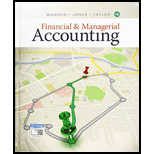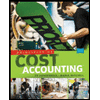
1.
Calculate the break-even point in sales units for the overall Product E for the current year.
1.
Explanation of Solution
Sales mix: It refers to the relative distribution of the total sales among the number of products sold by a company. In other words, it is expressed as a percentage of units sold for each product with respect to the total units sold for all the products.
Break-even Point: It refers to a point in the level of operations at which a company experiences its revenues generated is equal to its costs incurred. Thus, when a company reaches at its break-even point, it reports neither an income nor a loss from operations. The formula to calculate the break-even point in sales units is as follows:
Determine the break-even point in sales units for the overall Product E.
Fixed cost =$46,800
Contribution margin per unit =$10.40 per unit (3)
Working note (1):
Note: For break-even analysis, the Product-12” Pizza and Product-13” Pizza are considered as the components of one overall company’s Product E.
Determine the selling price per unit of Product E.
Working note (2):
Determine the variable cost per unit of Product E.
Working note (3):
Determine the unit contribution margin of Product E.
Therefore, the break-even point in sales units for the overall Product E for the current year is 4,500 units.
2.
Calculate the break-even sales (units) for Product-12” Pizza and Product-16” Pizza.
2.
Explanation of Solution
Determine the break-even point in sales units:
For Product-12” Pizza
Break-even point in sales units for Product E =4,500 units (refer Part a)
Sales Mix for Product Laptops =30%
For Product-16” Pizza
Break-even point in sales units for Product E =4,500 units (refer Part a)
Sales Mix for Product Tablets =70%
Therefore, the break-even point in sales units for the Product 12” Pizza is 1,350 units and for the Product 16” Pizza is 3,150 units.
3.
Compare the break-even point with that in Part (1).
3.
Explanation of Solution
The break-even point calculated in (1) with a sales mix of 50% 12” Pizza and 50% 16” Pizza is 4,680 units. It is more than the break-even point of 4,500 units calculated in Part 1.
The reason for the difference is the sales mix which is allocated at a lower percentage to the 12” Pizza (50%) and 16” Pizza (50%) in the present case. It resulted in the lower contribution margin per unit of $10.00 per unit than in Part 1 ($10.40 per unit). Thus, it increases the break-even point of sales (units) in the present case.
Working note (4):
Determine the break-even point in sales units for the overall Product E.
Fixed cost =$46,800
Contribution margin per unit =$10.00 per unit (7)
Note: For break-even analysis, the Product-12” Pizza and Product-16” Pizza are considered as the components of one overall company’s Product E.
Working note (5):
Determine the selling price per unit of Product E.
Working note (6):
Determine the variable cost per unit of Product E.
Working note (7):
Determine the unit contribution margin of Product E.
Working note (8):
Determine the break-even point in sales units:
For Product-12” Pizza
Break-even point in sales units for Product E =4,680 units (4)
Sales Mix for Product 12” Pizza =50%
Working note (9):
For Product-16” Pizza
Break-even point in sales units for Product E =4,680 units (4)
Sales Mix for Product 16” Pizza =50%
Want to see more full solutions like this?
Chapter 20 Solutions
Financial And Managerial Accounting
- There was no beginning balance in any inventory account.arrow_forwardClaymore Processing combines molasses and methanol. After joint manufacturing costs of $4,200 have been incurred, the mixture separates into two products: organic resin and methyl extract. At the split-off point, organic resin can be sold for $7,200, and methyl extract can be sold for $9,800. The resin can be further processed at a cost of $6,300 to make bio-resin blocks, which could be sold for $15,000. The methyl extract can be further processed at a cost of $7,400 to make a degreasing solvent, which could be sold for $16,000. What is the net increase (decrease) in operating income from bio-resin blocks?arrow_forwardHello, can u give correct Answerarrow_forward
- I am trying to find the accurate solution to this general accounting problem with appropriate explanations.arrow_forwardSarah's Bakery has $60,000 of fixed costs and variable costs of 40% of sales. How much total sales are needed to achieve a net income of $100,000?arrow_forwardThe investment resulted in increased sales and an increase in income that was 5% of the increase in sales.arrow_forward
- Please given correct answer for General accounting question I need step by step explanationarrow_forwardPlease explain the solution to this general accounting problem with accurate explanations.arrow_forwardI need help with this general accounting problem using proper accounting guidelines.arrow_forward
 Managerial AccountingAccountingISBN:9781337912020Author:Carl Warren, Ph.d. Cma William B. TaylerPublisher:South-Western College Pub
Managerial AccountingAccountingISBN:9781337912020Author:Carl Warren, Ph.d. Cma William B. TaylerPublisher:South-Western College Pub Financial And Managerial AccountingAccountingISBN:9781337902663Author:WARREN, Carl S.Publisher:Cengage Learning,Principles of Accounting Volume 2AccountingISBN:9781947172609Author:OpenStaxPublisher:OpenStax College
Financial And Managerial AccountingAccountingISBN:9781337902663Author:WARREN, Carl S.Publisher:Cengage Learning,Principles of Accounting Volume 2AccountingISBN:9781947172609Author:OpenStaxPublisher:OpenStax College Cornerstones of Cost Management (Cornerstones Ser...AccountingISBN:9781305970663Author:Don R. Hansen, Maryanne M. MowenPublisher:Cengage Learning
Cornerstones of Cost Management (Cornerstones Ser...AccountingISBN:9781305970663Author:Don R. Hansen, Maryanne M. MowenPublisher:Cengage Learning Managerial Accounting: The Cornerstone of Busines...AccountingISBN:9781337115773Author:Maryanne M. Mowen, Don R. Hansen, Dan L. HeitgerPublisher:Cengage Learning
Managerial Accounting: The Cornerstone of Busines...AccountingISBN:9781337115773Author:Maryanne M. Mowen, Don R. Hansen, Dan L. HeitgerPublisher:Cengage Learning Principles of Cost AccountingAccountingISBN:9781305087408Author:Edward J. Vanderbeck, Maria R. MitchellPublisher:Cengage Learning
Principles of Cost AccountingAccountingISBN:9781305087408Author:Edward J. Vanderbeck, Maria R. MitchellPublisher:Cengage Learning





